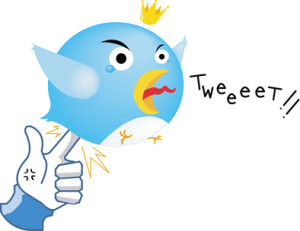
My last post talked about some of the advantages of using Twitter in a meeting: Keeping the audience’s attention; speeding up feedback; spontaneity; and enabling shy audience members to participate.
But I’m not sure the plusses would outweigh the minuses in most situations. I think it depends on what else is happening while the tweeting is going on. I recently appeared at an international IT conference, where the audience was encouraged to tweet during another speaker’s keynote. Many of the tweets were about the speech, but not helpful—they were saying things like “allright, get to the point already!” In that case, some audience members were serving as silent hecklers. If the goal of the presentation was to convey information rather than simply entertain, the tweeting was counterproductive.
Productive Uses for Twitter
On the other hand, when I did a national webinar for an aerospace company, the audience was also encouraged to tweet during the talk, but those tweets were mostly in response to questions I was posing or questions about the content of my talk. There was a facilitator in the studio with me, who reviewed the tweets and interrupted to ask me to address questions that were especially popular. This was a very good feature of the webinar, because without any studio audience, it would have been impossible for me to know how the attendees were reacting. And when the whole thing was over, I had a second-by-second record of the audience’s responses that I could use as feedback.
But I also know from multitasking research that at the time a tweeter is writing or an audience member is reading a tweet, he or she is not able to process the content of what the speaker is saying. You simply can’t do both things at once. Given that my talk was about multitasking, I asked the attendees to use their tweeting time as a teachable moment, to recognize that they were missing new content while tweeting. Fortunately, the presentation was recorded, so they could go back if they missed something important.
I believe there’s definitely the potential for using Twitter effectively in business, scientific, or educational presentations. But it needs to be used carefully.
How to Make Twitter Work
If you do encourage tweeting at your meeting or lecture, here are some ways to make it work:
- Don’t allow the audience to see the tweets scrolling by as you’re talking. If you want to share them with the audience, make a break to show the tweets as part of your presentation rather than having the tweets compete with you.
- Tell them you want them to tweet in response to specific questions (for which you’ll make breaks) – so they know when to tweet and what to tweet about.
- Incorporate their responses into your presentation in some way so they’ll feel validated and listened to.
- Make your presentation really interesting and fast-moving so they don’t have time to wander with their tweets – or even worse, so they don’t wander elsewhere in cyberspace; you may never get them back.
In short, if you want to incorporate tweets into your presentation, have a plan that will reduce the very great potential for distraction.
What do YOU think? Is it worth a try? — If you’ve tried it, did it help or hinder?
